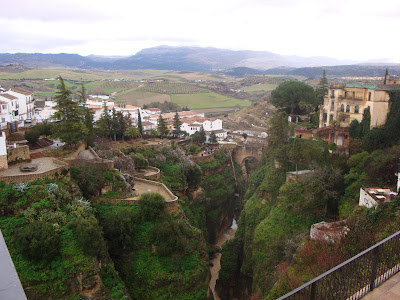Amsterdam: Unique is a word that comes to mind when I think about Amsterdam. What also comes to mind is crazy, mad, loony, weird, bizarre, extreme, excessive, insane and fascinating. There’s no other city in the world that can accurately be compared to Amsterdam because there’s simply no other city like it but I’ll give it a shot using multiple cities into one simple formula:
Amsterdam = (Canals of Venice + Renaissance Style) x Haight-Ashbury x Bicycles x Monte Carlo x Vegas ÷ (Buffets + Heat)
Or, more simply: A= (CV + RS) x HA x BI x MC x V ÷ (B +H)
While we were in Amsterdam we found time to visit the Anne Frank house. It was eerie to walk up the same stairs she did and look at the same walls she stared at for days and days.
Over the course of the semester, I have been going on excursions through ISA and seeing historical locations in Spain – The Alhambra, Cathedrals from centuries ago, Toledo, old mosques etc., etc. Anne Frank was living in the annex of the house less than seventy years ago. It’s hard to think about Anne being a 20th century historical figure, a modern historical figure.
Amsterdam is a place where a lot of people think differently and I think I’ll leave it at that.
Hostels: Awesome alternative to hotels. They’re filled with like-minded young people travelling and seeing new places. They are a great place to meet people and connect with people from all over the world. In Amsterdam, we even stayed at a boat hostel called Intersail.
Here, my roommate Murphy and I are hanging out on the dock in front of Intersail. Our quarters or cabin, a little boat jargon, is the smallest room I think I’ll ever see with four beds in it but we couldn’t care less. We were only there for sleeping and eating breakfast. My first hostel experience was a roaring success.
The Finnish Rapper: When the chance to study abroad came up I jumped at the opportunity. I wanted to see foreign places and meet people that think differently than the American archetype. I got all I could hope for then some from the man I happened to plop down next to on a bus ride from Brussels to Amsterdam. He loved to talk and for the next three hours, I let him.
Tommy is a passionate anti-capitalist, a holdover from the former Soviet Bloc. He is a strong believer that money is the root of all evil. He told me that he had an education from the real-world. He decided to forgo going to University or a trade school despite government subsidized post secondary education. He bluntly told me that with all the young, more-qualified Finns, he has almost no chance to get any employment he would enjoy in his native Finland.
Tommy seemed jaded when talking about Finland but he had a cheery overall demeanor about life. When we met he was scribbling down rap lyrics. He told me that everybody should do what they love. “I love rapping, so I rap,” he said with a smile. He told me he raps about three things, “Life, love, and respect.”
You can listen to Tommy here: http://www.myspace.com/lostadam
Note: In my further research of Finland I found information online that seemed to contrast what Tommy had told me. In 2009, Finland was ranked #1 (the U.S. came in at #9) on the Legatum Prosperity Index which is an annual ranking based on several different factors including: economic growth, personal well-being, wealth and quality of life.
Brussels: Brussels is boring. Don’t go to Brussels. Really, don’t go. Promise me you won’t go. I’m not kidding.
Brussels is home to the EU (snore). They have a giant atom monument (yawn). They have a statue of a little kid peeing (the fact that this is a major tourist attraction should tell you something).
Beach: I went to a beach in a town called Salobreña yesterday and took my first swim in the Mediterranean. It was quite cold. Afterwards, I felt like this:
At the beach in Salobreña, you can be playing around in the sand with your feet in the water and look back and see snow on the mountains a few miles back. It was strange.
A couple thoughts on the beach:
1) Pale is the new tan. I know I’ve been saying this for years, but this year it’s for real. Conan O’Brien is leading the charge. If ya ain’t pale, ya ain’t cool.
2) Every year that I get older it becomes more and more acceptable to have a large mane of dark chest hair - which I have and is delightful.
Next time: Spanish food (I know I said this before but next time it’s really happening) and why it makes perfect sense that Don Quixote is a Spaniard.


















